Photometry of super fast rotating, near-Earth asteroid 2015 KW120
- Adam Mickiewicz University in Poznań, Astronomical Observatory Institute, Faculty of Physics, Poland (pkolenczuk@gmail.com)
1. Introduction
Studying Very Small Asteroids (VSAs, effective diameter <150 m) is important for understanding the structure and evolution of asteroids and some non-gravitational effects (YORP and Yarkovsky effects). VSAs originate from collisions or rotational disintegration of larger bodies, which are the so-called rubble pile asteroids. Because VSAs are monoliths, they can have shorter rotation periods than the spin barier (P<2.2 h), which limits the rotation rates of rubble piles.
Due to their small sizes VSAs are usually observed as Near-Earth Asteroids (NEAs), during their close approaches to Earth. At that time they pose an observational challenge due to fast movement in te sky.
2015 KW120 is NEA belong to Apollo group. It was discovered on 24 May 2015 by Catalina Sky Survey (MPEC 2015-K99). At the night of our observations (29 May), it was closest to the Earth at 1.1 Earth-Moon distance and its magnitude (according to the MPC) was V=15.6.
2. Observations and data reduction
Observations were performed with a 0.7-m robotic RBT/PST2 telescope at Winer Observatory in Arizona, with the Andor iXon3 888 CCD camera, which has a field of view (FoV) 10' x 10'. We used a broadband filter L ("luminosity", transmission 370-700 nm), which can be thought of as a sum of the g and r SDSS bands. Each CCD frame was exposed for 15 seconds. Data were calibrated for bias and flat field.
As the proper motion of 2015 KW120 was very high (370 arcsec/min), the telescope followed the asteroid to keep it in the FoV and to maximize the S/N. In this way, the image of the asteroid remained round on the CCD frame, and the images of the stars were trailed (Fig. 1). Instrumental magnitude measurements for the asteroid were made using the standard aperture photometry method (Fig. 2).
Usually the changes of the atmosphere transparency affect a lightcurve. This can be prevented by using comparison stars. But in our case, with a fast-moving asteroid, we came across two issues:
1) Long trails of stars in the CCD frame, for which the appropriate aperture shape should be used (an ellipse or better a pill[4]). We could not do automatic photometry of such fast changing position trails using Starlink package[1]. (The aperture position would have to be manually specified.)
2) At this speed, potential comparison stars leave the FoV very quickly. Our estimates assume that we would need about 90 stars to cover the entire observation.
Both reasons make the differential photometry in this case very laborious. Fortunately, the night was photometric and the collected data are of good quality, allowing for accurate determination of the rotation period.
3. Rotation period
We determined the rotation period by folding curves with the least squares fit of the Fourier series. The algorithm of our program was described in [5].
We obtained 4 probable solutions for the period: P1, P2, P3 and P4 (see Fig. 3). The most likely is P2=0.1358 h (see solution P2 in Fig 3 and composite curve for P2 solution in Fig 4.). The two maxima and two minima of the brightness of this solution are typical for the commonly accepted triaxial ellipsoid approximation of the shape of most asteroids. We also analyzed the remaining 3 solutions in terms of the probability of a curve dominated by a given Fourier harmonic at a given peak-to-peak amplitude and the solar phase angle. For this, we used tables from [2]. As observations were made at the phase angle of 64-74° and the amplitude is about 1.35 mag (measured from the Fourier fit curve), other solutions are very unlikely.
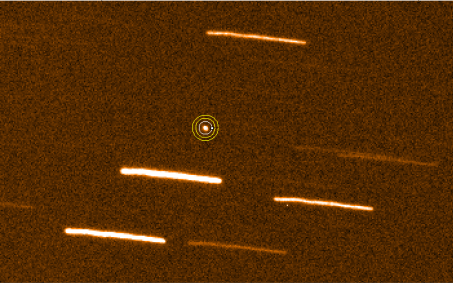
Fig. 1. A fragment of an example CCD frame, showing the trailed stars. The 2015 KW120 asteroid image is marked with a yellow aperture.
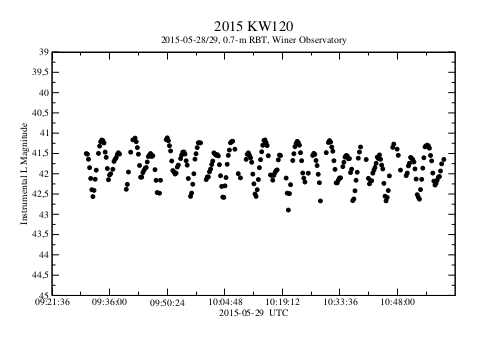
Fig. 2. Lightcurve of 2015 KW120
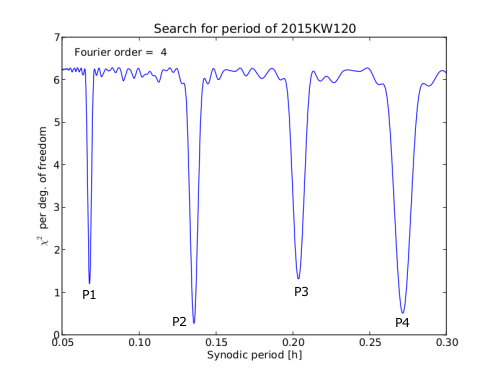
Fig. 3. Search period results showing a range of trial periods and the corresponding χ2 per degree of freedom. There are four possible solutions, marked by P1,P2,P3 and P4
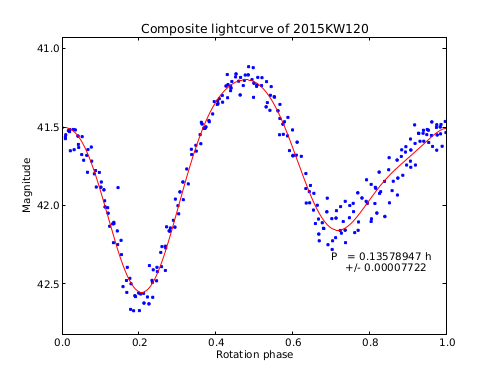
Fig. 4. Composite lightcurve of 2015 KW120 for the most probable rotation period P2.
4. The asteroid location in the period-diameter plot
The effective diameter can be determined from a standard equation given in [3]:
where: pV means the geometric albedo of the asteroid surface in the V band and H means absolute magnitude. The value of H=26 mag was taken from the Minor Planet Center. The albedo is not known for this asteroid, so we assumed pV=0.2 (this value is used in the Asteroid Lightcurve Database (LCDB) [6] for NEAs). Hence, we received D=19 m. The asteroid location in the PvsDeff plot is marked with a blue square in Figure 5. The asteroid definitely exceeds the spin barrier and is small in size, hence we conclude that it has a monolithic structure.
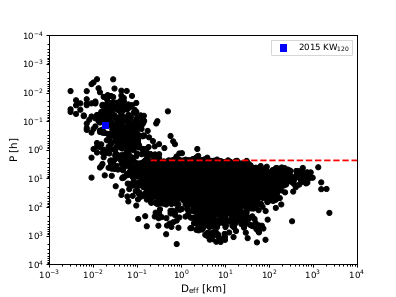
References
5. Summary
We observed 2015 KW120 asteroid, determined the rotation period P=0.1358±0.0001 h (8.147±0.006 min), and the amplitude peak-to-peak A=1.35 mag. Based on the location of the asteroid on the logP-logDeff chart, we conclude that the asteroid is a rapidly rotating monolith. In the near future, we are going to publish the results for other VSAs and also continue to observe objects of this type.
References
[1] Butkiewicz-Bąk et al. (2017) MNRAS 470, 1314-1320
[2] Currie et al. (2014) Astronomical Society of the Pacific Conference Series 485, 391
[3] Fowler and Chillemi (1992) Phillips Laboratory, Hanscom AF Base, MA, 17--43
[4] Fraser et al. (2016) The Astronomical Journal 151, 151-158
[5] Kwiatkowski et al. (2010) A&A 509, A94
[6] Warner et al. (2009) Icarus 202, 134
How to cite: Koleńczuk, P., Kwiatkowski, T., and Kamiński, K.: Photometry of super fast rotating, near-Earth asteroid 2015 KW120, Europlanet Science Congress 2020, online, 21 September–9 Oct 2020, EPSC2020-809, https://doi.org/10.5194/epsc2020-809, 2020

